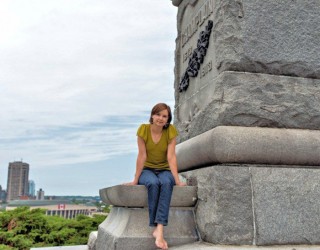Article Origin
Volume
Issue
Year
Self-described settler ally Trina Cooper-Bolam found a world of difference between Western and Indigenous practices of commemoration.
Bolam worked with residential school commemoration projects funded through the Indian Residential Schools Settlement Agreement. When she learned that no one was doing research on the commemoration projects that totaled $20 million, she decided to take it on for her Master’s thesis at Carleton University in Ottawa.
“It was so mind-boggling to me,” Bolam said, “that here we
had Indigenous people participating in commemoration on an unprecedented scale and nobody was looking at it. Commemoration was a component of that settlement agreement, and the TRC in their final report were reporting on all the elements of that agreement. I thought, if no one’s looking at this we’re not going to get the benefit of understanding what’s important to Indigenous people to
commemorate in the context of residential schools. The commemoration infrastructure that is supposed to commemorate is not going to change and if nobody studies this, we’re not even going to learn anything about what is
important to survivors to commemorate.”
Canada’s national program of historical commemoration, she said, honours people, places and events that are meaningful in Canadian history and is mainly done through the plaque program. Plaques go up on buildings or in parks. Sometimes, parks will be dedicated or if it’s something really
important, an interpretive centre will be built or a heritage site turned into a museum.
This approach, she said, is problematic because many Indigenous people would never want, or be able, to go to the residential schools attended by them or family members to see a plaque or similar marker.
Communities had to find ways to de-colonize the idea of commemoration and to do something that was meaningful to them.
What Bolam found with Indian residential school commemoration projects is they tended to be community-based rather than national in scope. She found other common elements to the projects across the country.
“First and foremost, people gathered,” she said. “They used
the opportunity to gather in ceremony, different types of ceremonies – healing ceremonies, smudging ceremonies. It was not only the survivors who gathered, but intergenerational survivors, entire families, entire communities and youth, and some had cultural teachings and workshops.”
The second element she found was that of sharing. There were sharing circles in which people shared stories and included a feast where they shared food. In some instances, the stories were recorded. The sharing circles also included round dances, Bolam said.
“Gathering, sharing and ceremony were very, very common elements of commemoration projects across the country,” Bolam said.
“It was really wonderful to see what people did – many beautiful monuments and works of art. Nothing prohibited the major museums in Canada from doing an exhibition on residential schools, yet the subject was barely represented in our museums.”
When she asked why this was the case, Bolam was told there are no residential school artifacts. Yet the Witness Blanket, a large-scale travelling art installation managed to secure hundreds of artifacts from survivors.
“That just flies in the face of what people from museums have said; that there is no artifactual record from the residential school era. They just didn’t go about seeking it. They didn’t seek the trust of the source communities to be able to even discuss, which doesn’t surprise me at all,” said Bolam, “given the historical relationship between first peoples and museums.”
Bolam submitted her report to the TRC for their consideration and is pleased that they referenced the report and included a couple of her recommendations. Her research was conducted independently without pay.
“The historical program on commemoration and the whole
infrastructure that runs it has to change,” she said. “Now we have proof that there are different ways of commemorating that are more appropriate, like healing from historical trauma and are more appropriate for Indigenous ways of healing than we have now.
“I’m sick of these celebratory histories of Canada that we
tell ourselves in our museums, in our history books, and in our sites and programs of commemoration. I won’t stand for that as a Canadian. It’s not acceptable. We have to start telling the truth. Stop celebrating the lie.”
Bolam is hoping to have her thesis published. In the meantime, it is available at: https://carleton-ca.academia.edu/TrinaBolam.
- 2944 views

